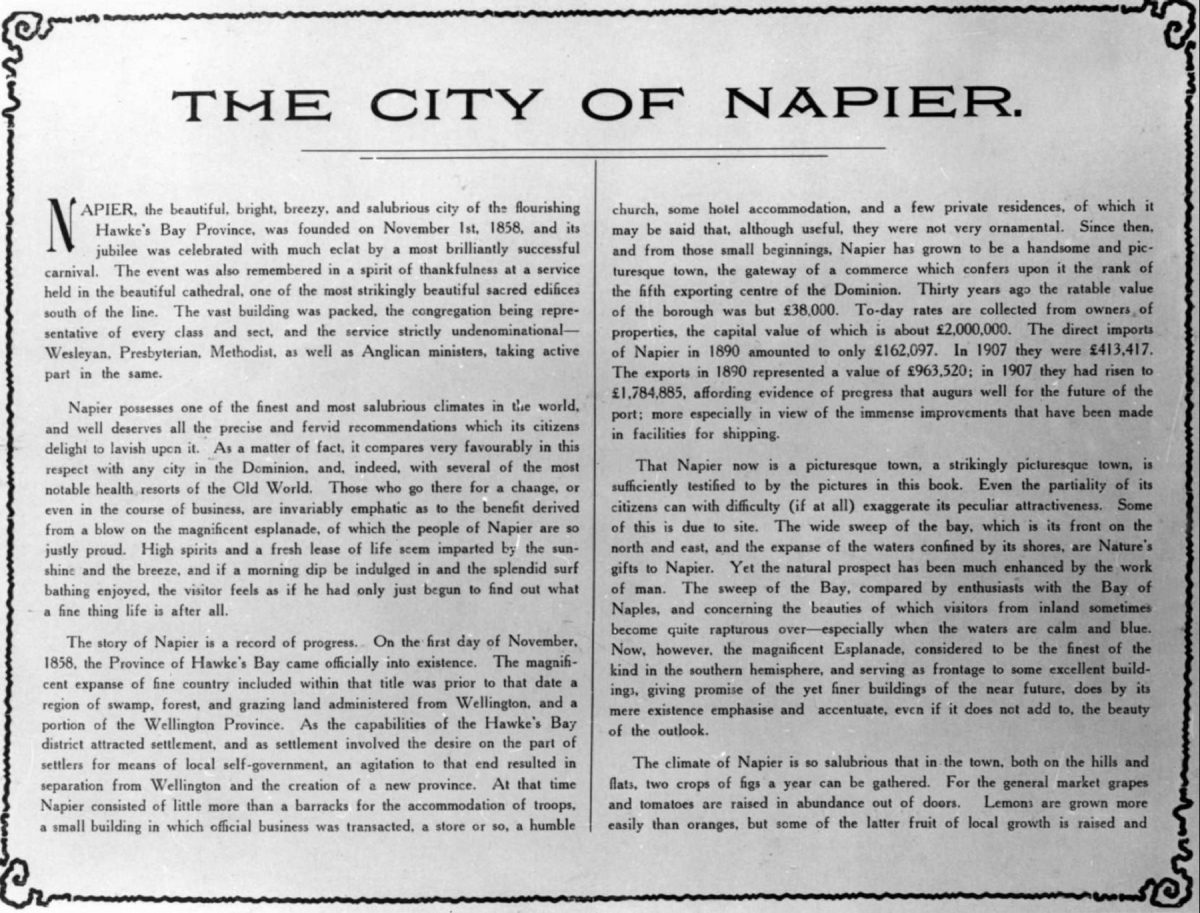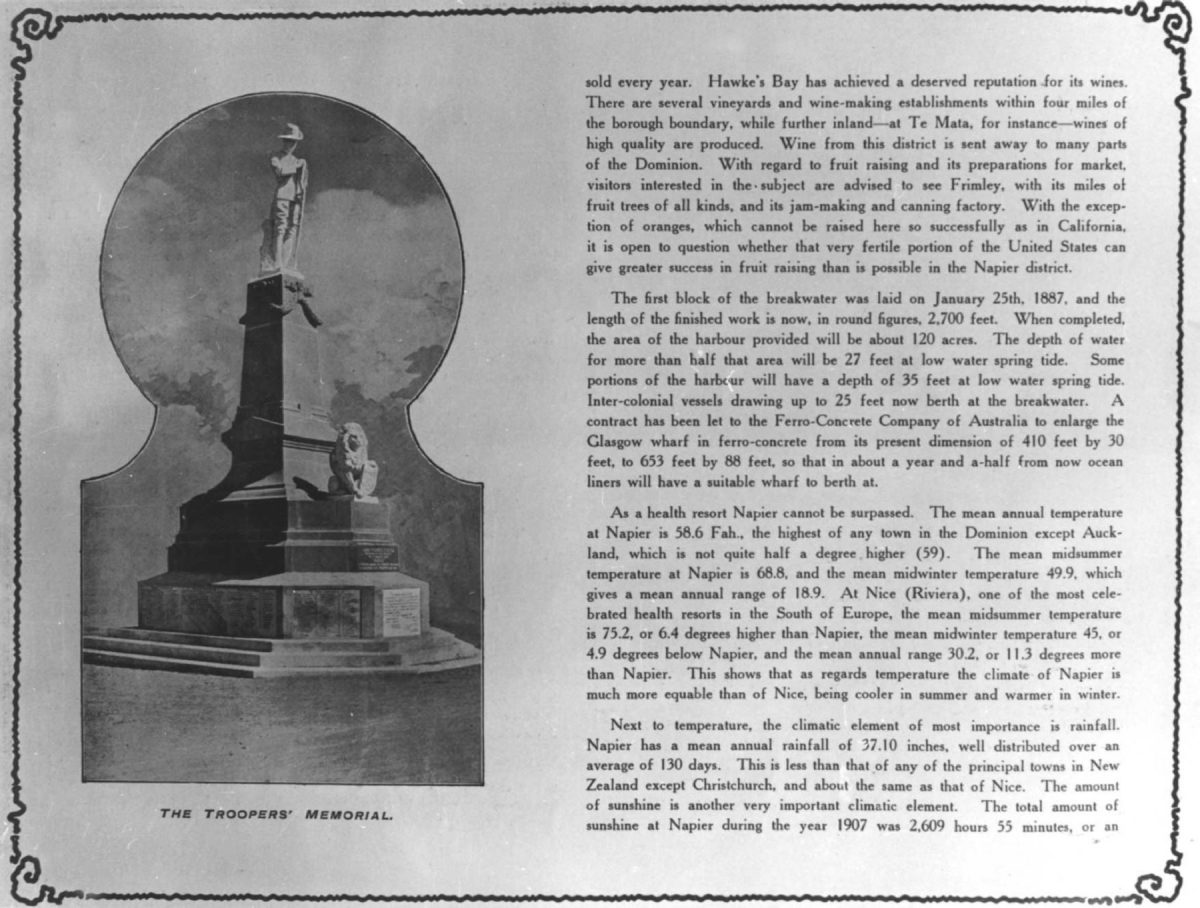THE CITY OF NAPIER.
NAPIER, the beautiful, bright, breezy, and salubrious city of the flourising Hawke’s Bay Province, was founded on November 1st, 1858, and its jubilee was celebrated with much eclat by a most brilliantly successful carnival. The event was also remembered in a spirit of thankfulness at a service held in the beautiful cathedral, one of the most strikingly beautiful sacred edifices south of the line. The vast building was packed, the congregation being representative of every class and sect, and the service strictly undenominational – Wesleyan, Presbyterian, Methodist, as well as Anglican ministers, taking active part in the same.
Napier possesses one of the finest and most salubrious climates in the world, and well deserves all the precise and fervid recommendations which its citizens delight to lavish upon it. As a matter of fact, it compares very favourably in this respect with any city in the Dominion, and, indeed, with several of the most notable health resorts of the Old World. Those who go there for a change, or even in the course of business, are invariably emphatic as to the benefit derived from a blow on the magnificent esplanade, of which the people of Napier are so justly proud. High spirits and a fresh lease of life seem imparted by the sunshine and the breeze, and if a morning dip be indulged in and the splendid surf bathing enjoyed, the visitor feels as if he had only just begun to find out what a fine thing life is after all.
The story of Napier is a record of progress. On the first day of November, 1858, the Province of Hawke’s Bay came officially into existence. The magnificient expanse of fine country included within that title was prior to that date a region of swamp, forest, and grazing land administered from Wellington, and a portion of the Wellington Province. As the capabilities of the Hawke’s Bay district attracted settlement, and as settlement involved the desire on the part of settlers for means of local self-government, an agitation to the end resulted in separation from Wellington and the creation of a new province. At that time Napier consisited of little more than a barracks for the accommodation of troops, a small building in which official business was transacted, a store or so, a humble church, some hotel accommodation, and a few private residences, of which it may be said that, although useful, they were not very ornamental. Since then, and from those small beginnings, Napier has grown to be a handsome and picturesque town, the gateway of a commerce which confers upon it the rank of the fifth exporting centre of the Dominion. Thirty years ago the ratable value of the borough was but £38,000. To-day rates are collected from owners of properties, the capital value of which is about £2,000,000. The direct imports of Napier in 1890 amounted to only £162,097. In 1907 the were £413,417. The exports in 1890 represented a value of £963,520; in 1907 they had risen to £1,784,885, affording evidence of progress that augurs well for the future of the port; more especially in view of the immense improvements that have been made in facilities for shipping.
That Napier now is a picturesque town, a strikingly picturesque town, is sufficiently testified to by the pictures in this book. Even the partiality of its citizens can with difficulty (if at all) exaggerate its peculiar attractiveness. Some of this is due to site. The wide sweep of the bay, which is its front on the north and east, and the expanse of the waters confined by its shores, are Nature’s gift to Napier. Yet the natural prospect has been much enhanced by the work of man. The sweep of the Bay, compared by enthusiasts with the Bay of Naples, and concerning the beauties of which visitors from inland sometimes become quite rapturous over – especially when the waters are calm and blue. Now, however, the magnificent Esplanade, considered to be the finest of the kind in the southern hemisphere, and serving as frontage to some excellent buildings, giving promise of the yet finer buildings of the near future, does by its mere existence emphasise and accentuate, even if it does not add to, the beauty of the outlook.
The climate of Napier is so salubrious that in the town, both on the hills and flats, two crops of figs a year can be gathered. For the general market grapes and tomatoes are raised in abundance out of doors. Lemons are grown more easily than oranges, but some of the latter fruit of local growth is raised and













Do you know something about this record?
Please note we cannot verify the accuracy of any information posted by the community.